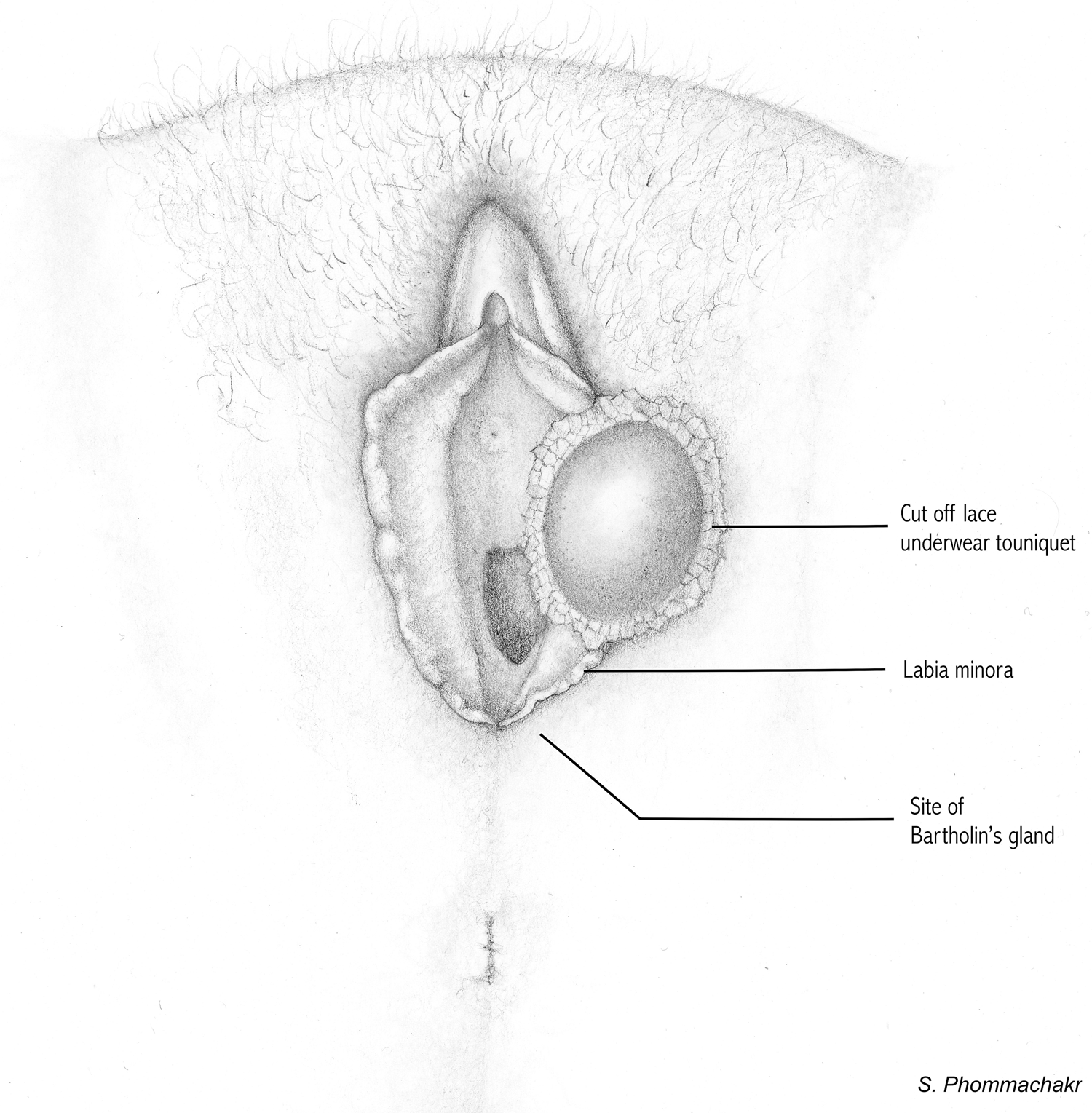INTRODUCTION
Tourniquet syndrome consists of a narrow constriction of an appendage, usually from hair threads, significantly decreasing lymphatic and venous drainage. If not relieved quickly it can result in pain, swelling, and edema that can progress to entrapment of the constricting agent in soft tissue.Reference Bacon and Burgis1 Without rapid resolution of the entrapment, permanent tissue necrosis can occur.
CASE PRESENTATION
We report a unique case of genital tourniquet syndrome in a healthy 24-year-old female after an evening spent at a dancehall party. The patient acknowledged consuming several alcoholic drinks and having participated in grinding—a type of erotic dance during which two dance partners push and rub their pelvic areas together during dance movements—over the course of several hours. At approximately 03:30, she was unable to remove her lace underwear and she started feeling an increasing pain and swelling of an area of her left labia minora that was entrapped in the lace. She presented to the emergency department at 04:30 complaining of genital pain unsuccessfully attempting to cut off her underwear at home. On arrival, she was afebrile, and her vital signs were normal. There were no associated urinary symptom and the patient denied any similar episode in the past. Examination revealed a tense, rounded area of left labia minora that was edematous and tender, constricted at its’ base by a lace band (Figure 1). We posited that a small fold of her labia minora got extruded through a mesh opening of her lace underwear by the sustained grinding dance move. At 04:45, the tourniquet was successfully relieved using local anesthesia and Metzenbaum scissors. Swelling was significantly reduced 30 minutes postresolution of the tourniquet, and the pain was virtually resolved upon discharge of the patient 1-hour after the procedure.

Figure 1. Labia minora tourniquet syndrome.
Tourniquet syndromes, which are generally accidental in nature, are most commonly reported in children in whom they typically affect fingers, toes, and genital organs and are secondary to hair thread in the very large majority of cases. It has been reported that only 2% of tourniquet syndromes affect the labia, whereas close to 50% involve the toes.Reference Golshevsky, Chuen and Tung2 This is the first reported case of a tourniquet syndrome of the labia minora due to erotic dancing in an adult female. To our knowledge, the only comparable report is a small case series of frictional paraphimosis, where the glans penis is entrapped by a tight ring of edematous foreskin requiring manual reduction, caused by sustained wining, an erotic dance native to Trinidad and Tobago.Reference Ramdass, Naraynsingh, Kuruvilla and Maharaj3
DISCUSSION
When rapidly recognized, a tourniquet syndrome can be addressed and treated promptly, thus preventing distal ischemia and necrosis of the entrapped tissue. The first step in management is usually trying to unwind the constricting hair or thread. If this fails, clinicians can consider using fine scissors to cut the hair or thread. The physician should obtain a surgeon's opinion in cases of deeper tourniquet featuring an imbedded constricting band that is not accessible. Although uncommon, clinicians working in acute care settings should be aware of the possibility of accidental tourniquet syndrome in adults presenting with acute constricting pain of appendages. The potential for reversibility of the neurovascular damage distal to the tourniquet depends on the duration of the strangulation. A prompt, focused physical examination is warranted to rule out a potential appendage-compromising tourniquet syndrome in patients presenting with similar symptoms. Finally, this case illustrates an issue for which clinicians must have an index of suspicion in more vulnerable patients, such as those with communication difficulties and in pediatric patients.



